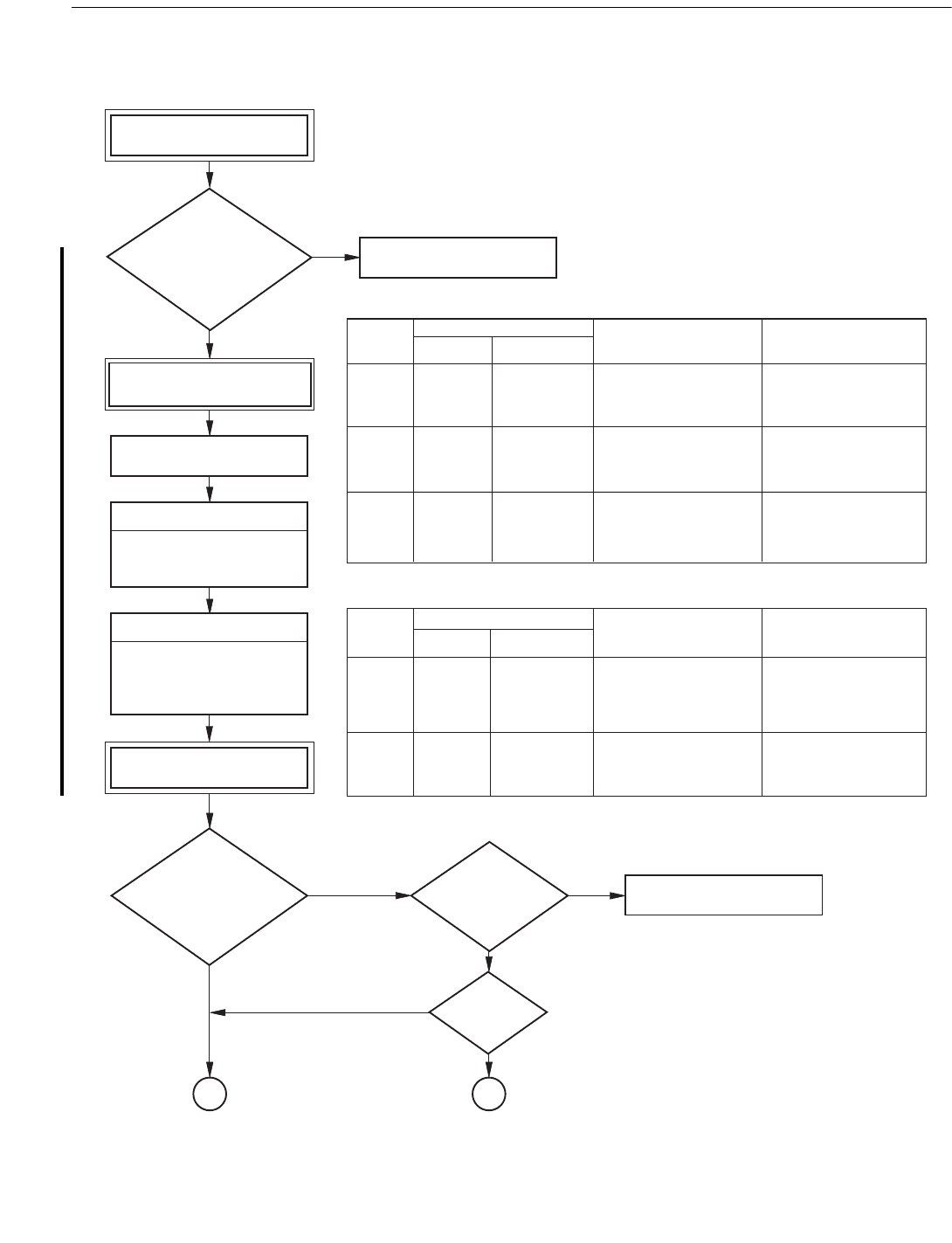API RP 2A-WSD-2007 Recommended Practice for Planning, Designing and Constructing Fixed Offshore Platforms-Working Stress Design
Подождите немного. Документ загружается.


RECOMMENDED PRACTICE FOR PLANNING, DESIGNING AND CONSTRUCTING FIXED OFFSHORE PLATFORMS—WORKING STRESS DESIGN 109
14.4.3 Special Surveys
A Level I survey should be conducted after direct exposure
to a design environmental event (e.g., hurricane, earthquake,
etc.).
A Level II survey should be conducted after severe acci-
dental loading that could lead to structural degradation (for
example, boat collision, dropped objects from a drilling pro-
gram, etc.), or after an event exceeding the platform’s original
design/assessment criteria.
Areas critical to the structural integrity of the platform,
which have undergone structural repair, should be subjected
to a Level II survey approximately one year following com-
pletion of the repair. A Level III survey should be performed
when excessive marine growth prevents visual inspection of
the repaired areas.
Level II scour surveys in scour-prone areas should take
account of local experience, and are usually more frequent
than the intervals indicated in Table 14.4.2-1. Interpreters of
periodic scour survey data should be aware that post-storm
infilling of scour holes can obscure the extent of scour in
storms.
14.5 PRESELECTED SURVEY AREAS
During initial platform design and any subsequent reanaly-
sis, critical members and joints should be identified to assist
in defining requirements for future platform surveys. Selec-
tion of critical areas should be based on such factors as joint
and member loads, stresses, stress concentrations, structural
redundancy, and fatigue lives determined during platform
design and/or platform assessment.
14.6 RECORDS
Records of all surveys should be retained by the operator
for the life of the platform. Such records should contain
detailed accounts of the survey findings, including video
tapes, photographs, measurements, and other pertinent survey
results. Records should also identify the survey levels per-
formed (that is, a Level IV survey should state whether a
Level III survey and/or Level II survey were performed).
Descriptions of detected damage should be thoroughly
documented and included with the survey results. Any result-
ing repairs and engineering evaluations of the platform’s con-
dition should be documented and retained.
15 Reuse
15.1 GENERAL
In general, platforms are designed for onshore fabrication,
loadout, transportation and offshore installation. By reversing
this construction sequence, platforms can be removed,
onloaded, transported, upgraded (if required) and reinstalled
at new sites. If a platform is reused the engineering design
principles and good practices contained in this publication
should apply.
15.2 REUSE CONSIDERATIONS
Reuse platforms require additional considerations with
respect to fatigue, material, inspection, removal and reinstal-
lation. These provisions are discussed in the following sec-
tions:
15.2.1 Fatigue Considerations for Reused
Platforms
For reused platforms having tubular connections inspected
in accordance with the minimum requirements of Section
15.2.3, fatigue considerations must include appropriate allow-
ances for fatigue damage that may have occurred during the
initial in-service period of the platform as well as the planned
service life at the new location. In general, Equation 5.2.5-1
should be satisfied. Beneficial effects on fatigue life from full
inspection and/or remedial measures may be considered when
determining prior damage or selecting safety factors.
The simplified fatigue analysis provisions addressed in
Section C5.1 may be used to assess tubular joints in reused
platforms, provided they are inspected per the minimum
requirements of Section 15.2.3, have prior and new locations
in less than 400 feet (122 m) of water, have similar wave cli-
mates with respect to platform orientation, are constructed of
ductile steels, have redundant structural framing and have
natural periods less than 3 seconds for both locations.
The Design Fatigue Life, L, in years should satisfy the fol-
lowing expression:
L = SF
1
L
1
+ SF
2
L
2
(15.2.1-1)
where
L
1
=initial in service period, years,
L
2
= planned service life at new location, years,
SF
1
= 2.0 for minimum requirements of Section 15.2.3.
If the weld in a tubular connection is 100% NDE
inspection in accordance with requirements of
15.2.3 and is upgraded if defects are found, SF
1
may be between zero and 2.0 selected on a rational
basis,
SF
2
=2.0.
For both safety factors, SF
1
and SF
2
, higher values for fail-
ure critical elements should be considered.
For the simplified fatigue analysis, the Allowable Peak Hot
Spot Stresses may be obtained from Figure C5.1-1 or C5.1-2
for the water depths at the prior and new site for the Design
Fatigue Life defined by Eq. 15.2.1-1. If the values are within
Copyright American Petroleum Institute
Provided by IHS under license with API
Licensee=Indonesia location/5940240008
Not for Resale, 10/22/2008 00:07:12 MDT
--`,,```,,,`,,,,,,,,,,,,,,`,``,`-`-`,,`,,`,`,,`---

110 API RECOMMENDED PRACTICE 2A-WSD
5%, then use the allowable Peak Hot Spot Stress for the depth
where the platform was or will be installed for the longest
durations. Otherwise, use the lower value.
Remedial measures (i.e., grinding welds, grouting, rein-
forcing, etc.) to increase the fatigue performance of a plat-
form to be reused are acceptable.
15.2.2 Steel in Reused Platforms
The type and grade of steel used in primary structural
members of platforms removed and reinstalled at new off-
shore sites should be determined from the original records. If
information on the type and grade of steel used is unavailable
from the original record, 33 ksi (225 Mpa) minimum yield
strength shall be assumed. In addition, tubular sections of
unknown steel type and grade with outside diameters typical
of drilling tubulars, e.g., 5
1
/
2
in., 9
5
/
8
in., 13
3
/
8
in., etc.,
should be avoided or removed from existing structures.
Reused platforms having tubular connections in which the
heavy wall joint-cans were inspected in accordance with the
requirements of Section 15.2.3 including UT inspection to
detect the occurrence of unacceptable defects.
15.2.3 Inspection of Reused Platforms
When structures are considered for reuse, inspection
should be required and testing performed to verify suitability
for the intended application. Such inspection and testing may
be performed prior to removal from the original site or at a
rework site.
15.2.3.1 General
Inspection programs prepared for evaluation of used struc-
tures being considered for reuse should be sufficiently
detailed to establish the condition of the structures. Addition-
ally, inspection should be performed to verify the absence of
damage which may impair the structure’s ability to withstand
loadings imposed during all phases of removal operations
from the prior site.
All pertinent assumptions made in the reanalysis should be
verified by inspection, including material composition and
properties, connection integrity, and extent of any corrosion
or other degradation due to prior service.
Assessment of condition of used structures should gener-
ally begin with review of existing documentation from the
original construction of the structure, together with results of
any past in-service surveys. Where documentation is com-
plete and in accordance with the requirements of Section
13.7, less field inspection may be justified, unless specific
knowledge of unusual events such as collisions, damage from
operations, etc., dictate additional review.
Applicable inspection techniques are covered in 13.4.3a.
15.2.3.2 Materials
The chemical composition and mechanical properties of all
materials should be verified for consistency with the assump-
tions made for the reanalysis. Mill certificates or other docu-
mentation from the original fabrication with adequate
material traceability may be used. Where such information is
lacking, physical testing should be performed by a qualified
laboratory.
Of particular importance is the verification of special mate-
rials such as steels classed as Groups II or III in Section 8.3.
In lieu of the above requirements, where 33 ksi (226 Mpa)
minimum yield strengths are assumed in the reanalysis,
inspection of materials may be limited to verifying that no
drilling tubulars are used in the structures.
15.2.3.3 Conditions of Structural Members and
Connections
Each structural member should be inspected to determine
extent of any corrosion or other mechanical damage (e.g., pit-
ting, dents, straightness, etc.) which would impair the
intended service of the platform.
All structural connections should be inspected to insure
that service damage (e.g., fatigue) does not impair the capa-
bility of the connection to carry design loads.
15.2.3.4 Damage-prone Connections
Damage-prone connections are defined as connections
having in-service stresses or loads (based on reanalyses for
the new location) equal to or greater than 90 percent of the
strength allowable or having 90 percent of the Peak Hot
Spot Stress (Simplified Fatigue Analysis) or fatigue damage
ratios (Detailed Fatigue Analysis) equal to or greater than
30 percent.
15.2.3.5 Extent of Weld Inspection
Inspection of all new member fabrication and new member
connections shall be performed per 13.4.3b. Weld inspection
plans for existing welds should generally conform to the
requirements of 13.4.3b, as modified herein.
15.2.3.5a Scheduling and Weld Access
Inspection techniques selected for use should consider
access requirements and limitations, both to the weld and
within the existing welded connections. Use of UT over RT
may be preferred due to equipment portability.
15.2.3.5b Extent of NDE Inspection
Documentation of NDE performed during the original fab-
rication and periodic in-service surveys of the platform
should be reviewed. Where adequate documentation exists
and weld qualities were consistent with current acceptance
Copyright American Petroleum Institute
Provided by IHS under license with API
Licensee=Indonesia location/5940240008
Not for Resale, 10/22/2008 00:07:12 MDT
--`,,```,,,`,,,,,,,,,,,,,,`,``,`-`-`,,`,,`,`,,`---

RECOMMENDED PRACTICE FOR PLANNING, DESIGNING AND CONSTRUCTING FIXED OFFSHORE PLATFORMS—WORKING STRESS DESIGN 111
criteria, inspection may be limited to an investigation of in-
service damage due to overload or fatigue.
Where such documentation is not available, an initial spot
survey of the structure should be made to provide guidance to
the engineer performing the reanalysis and to assist in the for-
mulation of a detailed inspection plan.
The spot survey should include a general overview of 100
percent of the uncleaned structure to be reused to detect any
gross structural damage (e.g., parted connections, missing
members, dented or buckled members, corrosion damage,
etc.). Structural members and connections suspected or
detected of having in-service damage should be 100 percent
NDE inspected.
All NDE inspected welds should be thoroughly cleaned so
as to enhance the effectiveness of the inspection.
Table 15.2.3.5 shows minimum recommended extent of
inspection for various existing parts of the structure.
Table 15.2.3.5—Recommended Extent of NDE Inspection—Reused Structure
Case Extent Method
Jacket Primary Tubulars
Longitudinal Weld Seams (L) (a) UT or MT
Circumferential Weld Seams (C) (a) UT or MT
Intersection of L&C (a) UT or MT
Tubular Joints
Major Brace-to-Chord Welds (b) MT
Major Brace-to-Brace Stub Welds (b) MT
Deck Members and Connections
Truss Bracing Members 10%* UT or MT
Truss Chord Members 10%* UT or MT
Plate Girder Members 10%* UT or MT
Connections to Deck Legs 25%* UT or MT
Crane Pedestal Connections 100% UT or MT
Cantilever Deck Connections 100% UT or MT
Survival/Safety Equipment Connections 100% UT or MT
Misc. Jacket/Deck Members and Connections
Nonredundant bracing and subassemblies, i.e., lifting eyes, lifting bracing,
sole conductor guide framing level above mudline, etc.
100% UT or MT
Copyright American Petroleum Institute
Provided by IHS under license with API
Licensee=Indonesia location/5940240008
Not for Resale, 10/22/2008 00:07:12 MDT
--`,,```,,,`,,,,,,,,,,,,,,`,``,`-`-`,,`,,`,`,,`---

112 API RECOMMENDED PRACTICE 2A-WSD
15.2.3.6 Corrosion Protection Systems
Corrosion protection systems integrity should be verified
in accordance with NACE RP-01-76 (1983 Revision). Verifi-
cation should include assessment of remaining anode materi-
als, anode connections, and condition of protective coatings,
to include splash zone coatings, wraps, etc. Inspection should
consider possible hidden damage under wraps, etc.
15.2.3.7 Inspections for Removal of Structures
from Prior Site
Inspection and documentation should be performed for all
phases of removal operations as defined in the offshore con-
struction plan. Structural and equipment weights should be
verified.
15.2.4 Removal and Reinstallation
15.2.4.1 Planning
All offshore construction should be accomplished in such a
manner that the platform can fulfill the intended design pur-
poses.
An offshore construction plan should be prepared for plat-
form removal and reinstallation. This plan should include the
method and procedures developed for the onloading, seafas-
tenings and transportation of all components and for the com-
plete reinstallation of the jacket, pile/conductors,
superstructure and equipment.
Plans for platform removal from the prior site should be
developed which describe methods and procedures for
removal of the deck, appurtenances, jacket and piling. Seafas-
tenings, transportation requirements, lift weights and centers
of gravity should be defined. Particular emphasis should be
placed on the prevention of damage of any platform compo-
nents intended for reuse as a result of removal operations.
Offshore construction plans may be in the form of written
descriptions, specifications, and/or drawings. Depending
upon the complexity of the installation, more detailed instruc-
tions may be required for special items such as grouting, div-
ing, welding/cutting, inspection, etc. Any restrictions or
limitations to operations due to items such as environmental
conditions, barge stability or structural strength (i.e., lifting
capacity), should be stated.
The offshore construction plan should normally be subdi-
vided into phases, for example—Removal, Onloading, Seaf-
Attachment Welds connecting nonredundant bracing/subassemblies to
main members
100% UT or MT
Redundant bracing and subassemblies, i.e., multi-level conductor guide
framing, secondary splash zone and mudline bracing, boat landings, etc.
10% Visual**
Attachment welds connecting redundant bracing/subassemblies to main members 10% Visual**
Piling
Longitudinal Weld Seams (L) 10% UT or RT
Circumferential Weld Seams (C) 10% UT or RT
Intersection of L & C 10% UT or RT
Filed Splices 100% UT or RT
* Partial inspection should be conducted as percentage of each piece, not 100 percent of percentage of the number of pieces.
** Limited to inspection of completed weld; may include MT and or PT.
(a) Extent of inspection for these welds should be determined by comparing the design loadings and stresses (including removal and reinstalla-
tion loads and stresses) for the new site with those to which the welds have previously been designed for and/or exposed. Where new design
loadings are less than or equal to initial design or actual loadings, then the extent of inspection, if any, should be determined based on NDE doc-
umentation or the results of the initial spot survey per Section 15.2.3.5b.
Where new design loadings are significantly greater than initial design or actual loadings, or when comparison based on initial design or actual
loadings is not possible, a minimum of one (1) bracing member and one (1) jacket leg spanning between each level should be inspected. Addi-
tional inspection per Section 15.2.3.5b should be performed where in-service damage is known of or suspected.
(b) All damage-prone connections should be inspected. Damage-Prone connections are defined in Section 15.2.3.4. Where NDE inspection of
these connections reveals significant defects, additional inspection of other connections should also be performed.
For tubular connections, a minimum of one (1) brace to chord connection at each level and X brace connection between levels, as applicable,
should be inspected.
For tubular connections not having Class A steel in the heavy wall joint-cans both UT and MT should be performed.
Table 15.2.3.5—Recommended Extent of NDE Inspection—Reused Structure (Continued)
Case Extent Method
Copyright American Petroleum Institute
Provided by IHS under license with API
Licensee=Indonesia location/5940240008
Not for Resale, 10/22/2008 00:07:12 MDT
--`,,```,,,`,,,,,,,,,,,,,,`,``,`-`-`,,`,,`,`,,`---

RECOMMENDED PRACTICE FOR PLANNING, DESIGNING AND CONSTRUCTING FIXED OFFSHORE PLATFORMS—WORKING STRESS DESIGN 113
astenings, Transportation, and Reinstallation. The party
responsible for each phase of the work should prepare the
plan for that phase, unless otherwise designated by the
Owner. Coordination and approval procedures between all
parties should be established by the Owner.
15.2.4.2 Records and Documentation
Adhere to the provisions of Section 12.1.2 during removal
and reinstallation.
15.2.4.3 Forces and Allowable Stresses
Adhere to the provisions of Section 12.1.3 during removal
and reinstallation.
15.2.4.4 Temporary Bracing and Rigging
Adhere to the provisions of Section 12.1.4 during removal
and reinstallation.
15.2.4.5 Removal
Jackets originally installed by lifting may be removed in a
process which essentially reverses the original installation
sequence. Jackets originally installed by launching which
cannot be lifted onto barges may be removed by controlled
deballasting, and skidding the jacket back onto a properly
configured launch barge. Such operations may require more
precise control of barge ballasting, positioning, and alignment
between jacket and barge than required for the original
launch. Environmental conditions for such operations may
also be more restrictive.
Anchorage during offshore removal operations should be
conducted in accordance with the basic principles outlined in
12.4.2.
15.2.4.6 Buoyancy and Refloating
When removal of used platforms from a prior site requires
refloating of platform components such as the jacket, addi-
tional buoyancy may be required in excess of that provided
when the structures were originally installed to compensate
for loss of buoyancy and for additional weights not present
during the original installation, i.e., grouted piling.
15.2.4.7 Marine Growth Removal
When removing used platforms for reuse, appropriate
equipment for marine growth removal from seafastening
locations should be provided. If the jacket is to be skidded
back onto a launch barge, marine growth should be removed
from launch cradles to ensure reasonable prediction of coeffi-
cient of friction and sling loads on padeyes and winches.
Waterblasting or sandblasting to remove marine growth has
been found effective.
15.2.4.8 Barge Stability
During removal of used platform components from a prior
site, ballasting of the barge for open water towing should be
completed prior to loading of platform components on the
barge, except where removal operation, otherwise dictate - e.g.,
reverse launching of jackets. If required to navigate shallow
waters, deballasting from open water tow conditions should not
be performed until the barge reaches sheltered waters.
15.2.4.9 Reinstallation
In general, the provisions of Section 12 should apply to the
reinstallation of used platforms.
16 Minimum and Special Structures
16.1 GENERAL
This section addresses additional considerations for the
design of non-jacket and special structures and single element
structural systems, as defined in 1.6.1d.
16.2 DESIGN LOADS AND ANALYSIS
16.2.1 Design Considerations
Proper structural design is based on maintaining member
stresses within certain allowable limits for the selected maxi-
mum design event. In addition, it is necessary to ensure that
the structure has proper redundancy and reserve strength to
prevent catastrophic failure or collapse if the selected design
event is exceeded. The typical well designed jacket type off-
shore platform has proven to exhibit these characteristics.
However, free standing caissons, guyed and braced caissons,
as well as single leg deck units and other single member
structural systems have less redundancy and may not neces-
sarily exhibit the same characteristics.
When using the wave criteria information from Section 2,
the allowable stress interaction ratio (or unity check) must be
limited to 0.85 for free standing caissons or single element
structural systems during storm conditions.
16.2.2 Dynamic Wave Analysis
A dynamic analysis utilizing the extreme wave sea state, in
accordance with 2.3.1c, should be performed for all mini-
mum Non-Jacket and Special structures with a natural period
equal to or greater than three seconds and for all free standing
caissons with a natural period of greater than two seconds.
For caissons with a natural period of less than three seconds,
approximate procedures may be applied. As an example, the
system may be considered as a undamped, single degree of
freedom cantilever with a uniformly distributed mass and a
lumped mass at the top.
In reference to the masses mentioned in 2.3.1c, the
dynamic model should include the maximum expected deck
live load. In these calculations for caissons it is necessary to
00
00
Copyright American Petroleum Institute
Provided by IHS under license with API
Licensee=Indonesia location/5940240008
Not for Resale, 10/22/2008 00:07:12 MDT
No reproduction or networking permitted without license from IHS

114 API RECOMMENDED PRACTICE 2A-WSD
consider the entire mass of the system including the caisson
and all internal casing, conductors, tubing, grout, entrapped
sea water as well as the virtual mass effects. Additional
moment due to P/Δ effects must be considered for the weight
of the deck.
16.2.3 Fatigue Analysis
A fatigue analysis including dynamic effects should be
performed in accordance with Sections 5.2 through 5.5. For
caissons with natural periods less than two seconds, and in a
water depth less than 50 feet, fatigue design in accordance
with C5.1 may be used in lieu of dynamic fatigue analysis.
16.2.4 Foundation Effects
Experience has shown that due to the prolonged large
deflection of caissons and other more flexible structures, the
soil at and near the surface is subject to substantial degrada-
tion and frequently loses contact with the caisson for a short
distance below the surface. This loss of soil strength due to
remolding and the effective increase in unsupported length of
the caisson should be considered in determining dynamic
effects and the resulting bending stresses.
After severe storms in the Gulf of Mexico, caissons have
been observed to be leaning with no visible overstressor dam-
age to the caisson. This may have been caused by inadequate
penetration which resulted in the ultimate lateral resistance of
the soil being exceeded. Caissons should be designed for lat-
eral loading in accordance with Section 6.8 with sufficient
penetration to assure that the analysis is valid. Analysis proce-
dures using “fixity” at an assumed penetration should be lim-
ited to preliminary designs only. For caissons, the safety factor
for the overload case discussed in 6.8.1, should be at least 1.5.
16.3 CONNECTIONS
This section provides guidelines and considerations for uti-
lizing connection types other than welded tubular connections
as covered in Section 4. Connection types are as follows:
Bolted
Pinned
Clamped
Grouted
Doubler Plate
Threaded
Swagged
16.3.1 Analysis
Connections should be analyzed following the general
guidelines of Section 4.3.5. Member forces should be
obtained from the global structure analysis.
16.3.2 Field Installation
Where connections are designed to be field installed,
inspection methods should be developed to ensure proper
installation in accordance with design assumptions. As an
example, the tension in high strength bolts should be field
verified utilizing mechanical or procedural methods.
16.3.3 Special Considerations
16.3.3.a Bolted Connections
These joints should be designed in accordance with appro-
priate industry standards such as AISC Specification for
Structural Joints using ASTM A325 or A490 bolts.
Consideration should be given to punching shear, lamellar
tearing, friction factors, plate or shell element stresses, relax-
ation, pipe crushing, stress corrosion cracking, bolt fatigue,
brittle failure, and other factors or combinations that may be
present.
Retightening or possible replacement of bolts should be
included as part of the owner’s period surveys as defined in
Section 14.
16.3.3.b Joints with Doubler, and/or Gusset Plates
Consideration should be given to punching shear, lamellar
tearing, pullout, element stresses, effective weld length, stress
concentrations and excessive rotation.
16.3.3.c Pinned Connections
These connections may significantly influence member
forces; therefore pin ended tubular joints should be modeled
in accordance with the actual detailing for fabrication.
16.3.3.d Grouted Connections
These connections should be designed in accordance with
Section 7.4; however, all axial load transfer should be accom-
plished using shear keys only.
16.3.3.e Clamped Connections
Where primary members rely on friction to transfer load, it
should be demonstrated, using appropriate analytical methods
or experimental testing, that adequate load transfer will be
developed and maintained during the life of the structure.
Consideration should be given to the member crushing load
when developing the friction mechanism.
16.4 MATERIAL AND WELDING
16.4.1 Primary Connections
Steel used for primary tubular joints or other primary con-
nections should be Class A steels as defined in Section 8.1.3c
or equivalent. Primary joints or connections are those, the
failure of which, would cause significant loss of structural strength.
00
00
00
00
Copyright American Petroleum Institute
Provided by IHS under license with API
Licensee=Indonesia location/5940240008
Not for Resale, 10/22/2008 00:07:12 MDT
--`,,```,,,`,,,,,,,,,,,,,,`,``,`-`-`,,`,,`,`,,`---

RECOMMENDED PRACTICE FOR PLANNING, DESIGNING AND CONSTRUCTING FIXED OFFSHORE PLATFORMS—WORKING STRESS DESIGN 115
16.4.2 Caisson Materials
Caissons may be fabricated utilizing Class C steel, as
defined in 8.1.3a, if interaction ratios (as defined in Section 3)
are equal to or less than 0.85 for all design loading conditions.
16.4.3 Caisson Welding
For field welds in caissons, special attention should be
given to the provisions for complete joint penetration butt
welds in AWS D1.1-2002, Sections 3.13 and 4.12, or else
reduced fatigue performance (e.g., AWS Curve E) and root
deduction should be considered.
17 Assessment of Existing Platforms
17.1 GENERAL
This section is applicable only for the assessment of plat-
forms which were designed in accordance with the provi-
sions in the 20th and earlier editions and for platforms
designed prior to the first edition of this publication. For
structures which were designed in accordance with the 21st
Edition and later editions, assessment should be in accor-
dance with the criteria originally used for the design of the
platform. However, if factors affecting life-safety or conse-
quence of failure have changed, then for L-1 and L-2 plat-
forms, a special study to review the platform categorization
may be performed to justify a reduced Exposure Category as
defined in Section 1.7. No reduction in criteria can be con-
sidered for L-3 platforms.
In some cases, a platform owner may consider a change in
the use of an existing platform which differs from its original
purpose. In these instances, the platform has undergone a
Change-of-Use and the reduced metocean criteria of this sec-
tion may not be applicable. However, the engineering
approaches used for the assessment of an existing platform
would still be valid. The owner should carefully consider if
design criteria for new platforms as defined in Section 2 is
appropriate, or if assessment criteria as defined in this Section
is appropriate. See also Section C17.1.
These guidelines are divided into separate sections
describing assessment initiators, exposure categories, plat-
form information necessary for assessment, the assessment
process criteria/loads, design and ultimate strength level
analysis requirements and mitigations. Several references [1-
8] are noted which provide background, criteria basis, addi-
tional details and/or guidance including more specific tech-
nical references.
The guidelines in this section are based on the collective
industry experience gained to date and serve as a recom-
mended practice for those who are concerned with the
assessment of existing platforms to determine their fitness
for purpose.
The reduced criteria herein may leave a platform vulnera-
ble to damage or collapse in a hurricane, particularly for an
A-3 Low Assessment Category platform, as defined in Sec-
tion 17.3. The assessment approach is structured so that the
damage to or collapse of a platform will not increase life
safety or environmental risk, however, it may create an eco-
nomic burden to the owner in terms of facility and produc-
tion losses. The determination of an acceptable level of
economic risk is left to the operator’s discretion. It can be
beneficial for an operator to perform explicit cost-benefit
risk analyses in addition to simply using this recommended
practice. See also Section C17.1.
17.2 PLATFORM ASSESSMENT INITIATORS
An existing platform should undergo the assessment pro-
cess if one or more of the conditions noted in 17.2.1 through
17.2.5 exist.
Any structure that has been totally decommissioned (for
example, an unmanned platform with inactive flowlines and
all wells plugged and abandoned) or is in the process of being
removed (for example, wells being plugged and abandoned)
is not subject to this assessment process.
17.2.1 Addition of Personnel
If the life safety level (as defined in Section 1.7.1) is
changed to a more restrictive level, the platform must be
assessed.
17.2.2 Addition of Facilities
If the original operational loads on a structure or the level
deemed acceptable by the most recent assessment are signifi-
cantly exceeded by the addition of facilities (for example,
pipelines, wells, significant increase in topside hydrocarbon
inventory capacity) or the consequence of failure level noted
in Section 1.7.2 changes, the platform must be assessed.
17.2.3 Increased Loading on Structure
If the structure is altered such that the new combined envi-
ronmental/operational loading is significantly increased
beyond the combined loadings of the original design using
the original design criteria or the level deemed acceptable by
the most recent assessment, the structure must be assessed.
See 17.2.6 for definition of “significant.”
17.2.4 Inadequate Deck Height
If the platform has an inadequate deck height for its expo-
sure category (see Sections 17.3 and 17.6.2; for U.S. Gulf of
Mexico, also see Section 17.6.2a-2 and Figures 17.6.2-2b,
3b, and 5b) and the platform was not designed for the
impact of wave loading on the deck, the platform must be
assessed. The minimum elevation indicated in these figures
00
00
05
05
05
Copyright American Petroleum Institute
Provided by IHS under license with API
Licensee=Indonesia location/5940240008
Not for Resale, 10/22/2008 00:07:12 MDT
--`,,```,,,`,,,,,,,,,,,,,,`,``,`-`-`,,`,,`,`,,`---

116 API RECOMMENDED PRACTICE 2A-WSD
is measured to the underside of the support structure for the
lowest substantial deck, which is typically called the cellar
deck as defined in Section C17.2.4. In some cases lower
decks or other large construction and/or equipment below
the cellar deck may need to be considered as the lowest sub-
stantial deck for the assessment trigger. If in doubt, the low-
est substantial deck should be used for the assessment
trigger.
17.2.5 Damage Found During Inspections
The assessment process may be used to assess the fitness
for purpose of a structure when significant damage to a pri-
mary structural component is found during any inspection.
This includes both routine and special inspections as required
and defined in Section 14. Minor structural damage may be
justified by appropriate structural analysis without perform-
ing a detailed assessment. However, the cumulative effects of
damage must be documented and, if not justified as insignifi-
cant, be accounted for in the detailed assessment.
17.2.6 Definition of Significant
Cumulative decreases in platform system capacity due to
damage or cumulative increases in platform system loading
due to changes from the design premise are considered to be
significant if the total of the cumulative changes is greater
than 10 percent. For example, if there is a 7% decrease in sys-
tem capacity due to damage and a 5% increase in system
loading due to changes, then the combined total of 12% is
considered significant.
17.3 PLATFORM ASSESSMENT CATEGORIES
Structures should be assessed in accordance with the appli-
cable Assessment Category and corresponding assessment
criteria as defined in this section. The Assessment Categories,
known as A-1, A-2, and A-3, are defined as the most restric-
tive of life safety or consequence of failure considerations,
similar to Section 1.7 for design of new platforms. For exist-
ing platforms, life safety considerations have the same defini-
tion as in Section 1.7. Consequence of failure considerations
are similar to Section 1.7, with additional clarifications as
noted below. See also Table 17.5.2.
A-1 – High Assessment Category. This refers to existing
major platforms and/or those platforms that have the potential
for well flow of either oil or sour gas in the event of platform
failure. In addition, it includes platforms where the shut-in of
the oil or sour gas production is not planned, or not practical
prior to the occurrence of the design event (such as areas of
high seismic activity). Platforms that support major oil trans-
port lines (see Commentary C1.7.2–Pipelines) and/or storage
facilities for intermittent oil shipment are also considered to
be A-1, as defined in Section 1.7.2a. A-1 platforms can be
manned non-evacuated, manned evacuated or unmanned as
defined in Section 1.7.1. All platforms in water depths greater
than 400 ft. are considered A-1.
A-2 – Medium Assessment Category. This refers to existing
platforms where production would be shut-in during the
design event. All wells that could flow on their own in the
event of platform failure must contain fully functional, sub-
surface safety valves which are manufactured and tested in
accordance with applicable API specifications. Oil storage is
limited to process inventory and “surge” tanks for pipeline
transfer, as defined in Section 1.7.2b. A-2 platforms can be
manned evacuated or unmanned as defined in Sections
1.7.1.b and 1.7.1.c, respectively. These are essentially exist-
ing platforms that do not meet the A-1 or A-3 definitions.
A-3 – Low Assessment Category. This refers to existing
platforms where production would be shut-in during the
design event. All wells that could flow on their own in the
event of platform failure must contain fully functional, sub-
surface safety valves, which are manufactured and tested in
accordance with applicable API specifications. These plat-
forms may support production departing from the platform
and low volume infield operations. Oil storage is limited to
process inventory, as defined in Section 1.7.2.c. The five
well completion, two piece of production equipment, and
100 ft. water depth limit requirements contained in Section
1.7.2c for new platforms are not always valid for existing A-
3 platforms. It is possible that some older, larger platforms
with more wells, more production equipment and deeper
water that are nearing the end of their useful life have a simi-
lar consequence of failure and can be considered A-3. This
category typically includes low consequence auxiliary struc-
tures such as bridge supports and flare towers, although in
some cases these structures should be considered A-2 based
upon their consequence of failure. A-3 platforms are always
unmanned as defined in Section 1.7.1c.
17.4 PLATFORM ASSESSMENT INFORMATION—
SURVEYS
17.4.1 General
Sufficient information should be collected to allow an
engineering assessment of a platform’s overall structural
integrity. It is essential to have a current inventory of the
platform’s structural condition and facilities. The operator
should ensure that any assumptions made are reasonable and
information gathered is both accurate and representative of
actual conditions at the time of the assessment. Additional
details can be found in C17.4.1 and in both “An Integrated
Approach for Underwater Survey and Damage
Assessment
of Offshore Platforms,” by J. Kallaby and P. O’Connor, [2]
and “Structural Assessment of Existing Platforms,” by J.
Kallaby, et al. [3].
05
05
05
Copyright American Petroleum Institute
Provided by IHS under license with API
Licensee=Indonesia location/5940240008
Not for Resale, 10/22/2008 00:07:12 MDT
No reproduction or networking permitted without license from IHS

RECOMMENDED PRACTICE FOR PLANNING, DESIGNING AND CONSTRUCTING FIXED OFFSHORE PLATFORMS—WORKING STRESS DESIGN 117
17.4.2 Surveys
17.4.2.1 Topside
The topside survey should, in most instances, only require
the annual Level I survey as required in Section 14.3.1. The
accuracy of the platform drawings should be verified when
necessary. Where drawings are unavailable or inaccurate,
additional walkaround surveys of the topside structure and
facilities could be required to collect the necessary informa-
tion; for example, topside arrangement and configuration,
platform exposure category (see Section 1.7), structural fram-
ing details, etc.
17.4.2.2 Underwater
The underwater survey should, as a minimum, comprise a
Level II survey (existing records or new survey), as required
in Section 14.3.2.
In some instances, engineering judgment may necessitate
additional Level III/Level IV surveys, as required in Sections
14.3.3 and 14.3.4, to verify suspected damage, deterioration
due to age, lack of joint cans, major modifications, lack of/
suspect accuracy of platform drawings, poor inspection
records, or analytical findings. The survey should be planned
by personnel familiar with inspection processes. The survey
results should be evaluated by a qualified engineer familiar
with the structural integrity aspects of the platform(s).
17.4.3 Soil Data
Available on- or near-site soil borings and geophysical data
should be reviewed. Many older platforms were installed
based on soil boring information a considerable distance
away from the installation site. Interpretation of the soil pro-
file can be improved based on more recent site investigations
(with improved sampling techniques and in-place tests) per-
formed for other nearby structures. More recent and refined
geophysical data might also be available to correlate with soil
boring data developing an improved foundation model.
17.5 ASSESSMENT PROCESS
17.5.1 General
The assessment process for existing platforms separates
the treatment of life safety and consequence of failure issues,
and applies criteria that depend upon location and conse-
quences. Additional details regarding the development and
basis of this process can be found in “Process for Assessment
of Existing Platforms to Determine Their Fitness for Pur-
pose,” by W. Krieger, et al. [4], with supporting experience in
“A Comparison of Analytically Predicted Platform Damage
to Actual Platform Damage During Hurricane Andrew,” by F.
J. Puskar, [5].
There are six components of the assessment process, which
are shown in double line boxes in Figure 17.5.2:
1. Platform selection (Section 17.2).
2. Categorization (Section 17.3).
3. Condition assessment (Section 17.4).
4. Design basis check (Sections 17.5 and 17.6).
5. Analysis check (Sections 17.6 and 17.7).
6. Consideration of mitigations (Section 17.8).
The screening of platforms to determine which ones should
proceed to detailed analysis is performed by executing the
first three components of the assessment process. If a struc-
ture does not pass screening, there are two potential sequen-
tial analysis checks:
1. Design level analysis.
2. Ultimate strength analysis.
The design level analysis is a simpler and more conserva-
tive check, while the ultimate strength analysis is more com-
plex and less conservative. It is generally more efficient to
begin with a design level analysis, only proceeding with ulti-
mate strength analysis as needed. However, it is permissible
to bypass the design level analysis and to proceed directly
with an ultimate strength analysis. If an ultimate strength
analysis is required, it is recommended to start with a linear
global analysis (see Section 17.7.3a), proceeding to a global
inelastic analysis (see Section 17.7.3c) only if necessary.
Mitigation alternatives noted in Section 17.8 (such as plat-
form strengthening, repair of damage, load reduction, or
changes in exposure category) may be considered at any
stage of the assessment process.
In addition, the following are acceptable alternative assess-
ment procedures subject to the limitations noted in C17.5.1:
1. Assessment of similar platforms by comparison.
2. Assessment through the use of explicit probabilities of
failure.
3. Assessment based on prior exposure, surviving actual
exposure to an event that is known with confidence to
have been either as severe or more severe than the
applicable ultimate strength criteria based on the expo-
sure category.
Assessment procedures for metocean, seismic, and ice
loading are defined in 17.5.2, 17.5.3, and 17.5.4, respectively.
17.5.2 Assessment for Metocean Loading
The assessment process for metocean loading is shown in
Figure 17.5.2. A different approach to defining metocean cri-
teria is taken for U.S. Gulf of Mexico platforms than for other
locations. For the U.S. Gulf of Mexico, the design level and
ultimate strength metocean crite
ria are explicitly provided,
including wave height versus water depth curves.
For other U.S. areas, metocean criteria are specified in
terms of factors relative to loads caused by 100-year environ-
05
Copyright American Petroleum Institute
Provided by IHS under license with API
Licensee=Indonesia location/5940240008
Not for Resale, 10/22/2008 00:07:12 MDT
--`,,```,,,`,,,,,,,,,,,,,,`,``,`-`-`,,`,,`,`,,`---

118 API RECOMMENDED PRACTICE 2A-WSD
Figure 17.5.2—Platform Assessment Process—Metocean Loading
PLATFORM SELECTION
CATEGORIZATION
(see Section 17.3)
Exposure Category
Consequence
of Failure
Life Safety
Assessm ent
Cat e g o r y
Design Level Analysis
(see Notes 1 and 2)
Ultimate Strength
Analysis
CONDITION ASSESSMENT
(see Section 17.4)
Assessment category based on:
Life safety, Consequence of Failure
Life Safety
• Manned-Non-Evacuated
• Manned-Evacuated
• Unmanned
Consequence of Failure
• High Consequence
• Medium Consequence
• Low Consequence
Notes 1. Design level analysis not applicable for platforms with inadequate deck height.
2. One-third increase in allowable stress is permitted for design level analysis (all categories).
A-1
No
Yes
No
Yes
Yes
No
No
Yes
(see Table 17.6.2-1)
(see Table 17.6.2-2)
Manned-
Non-Evacuated,
Manned-
Evacuated or
Unmanned
Manned-
Non-Evacuated
or
Unmanned
Unmanned
High Consequence
design level
analysis loading
(see Figure 17.6.2-2a)
High Consequence
ultimate strength
analysis loading
(see Figure 17.6.2-2a)
A-2
A-3
High
Low
Medium
High
Low
Manned-
Evacuated or
Unmanned
Sudden hurricane
design level
analysis loading
(see Figure 17.6.2-3a)
Sudden hurricane
ultimate strength
analysis loading
(see Figure 17.6.2-3a)
Design Level Analysis
(see Not es 1 and 2)
Ultimate Strength
Analysis
85% of lateral loading
caused by 100-year
environmental conditions
(see Section 17.6.2b)
Reserve strength ratio
(RSR) ³ 1.6
(see Section 17.6.2b)
50% of lateral loading
caused by 100-year
environmental conditions
(see Section 17.6.2b)
(RSR) ³ 0.8
(see Section 17.6.2b)
Unmanned
Minimum consequence
design level analysis
loading
(see Figure 17.6.2-5a)
Minimum consequence
ultimate strength
analysis loading
(see Figure 17.6.2-5a)
Is
platform damaged,
deck height inadequate,
or has loading increased ?
(see Section17.6,
17.7)
Do any
assessment initiators
exist? (see Section 17.2) or
Is there a regulatory
requirement for
assessment?
Assessment not required
Assessm ent n o t required
Is
platform location
GOM ?
Is
platform unmanned and
low consequence?
Table 17.5.2a−ASSESSMENT CRITERIA−U.S. GULF OF MEXICO
Table 17.5.2b−ASSESSMENT CRITERIA−OTHER U.S. AREAS
A-1
A-3
Exposure Category
Consequence
of Failure
Life Safety
Assessm ent
Cat e g o r y
B
A
05
Copyright American Petroleum Institute
Provided by IHS under license with API
Licensee=Indonesia location/5940240008
Not for Resale, 10/22/2008 00:07:12 MDT
--`,,```,,,`,,,,,,,,,,,,,,`,``,`-`-`,,`,,`,`,,`---
